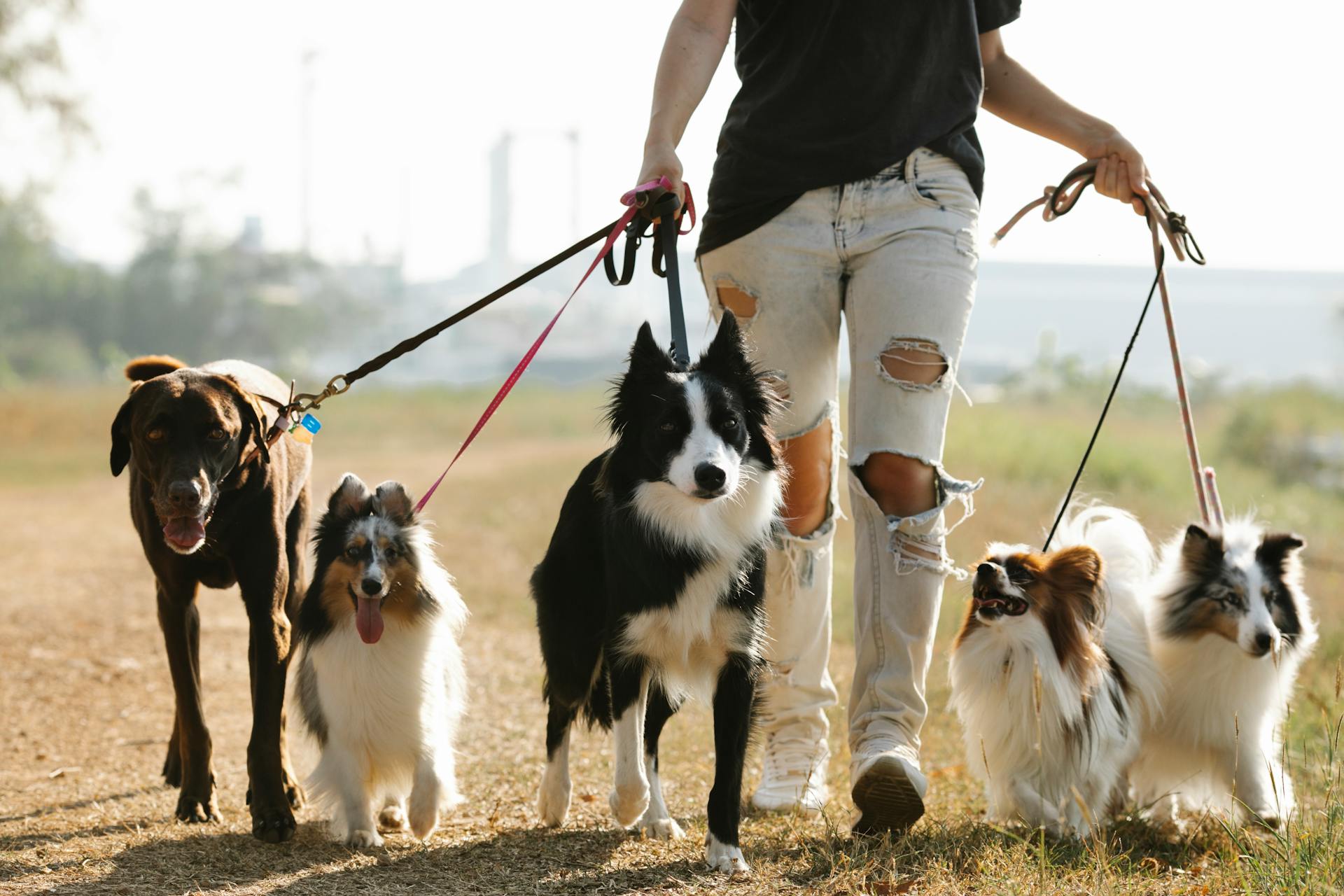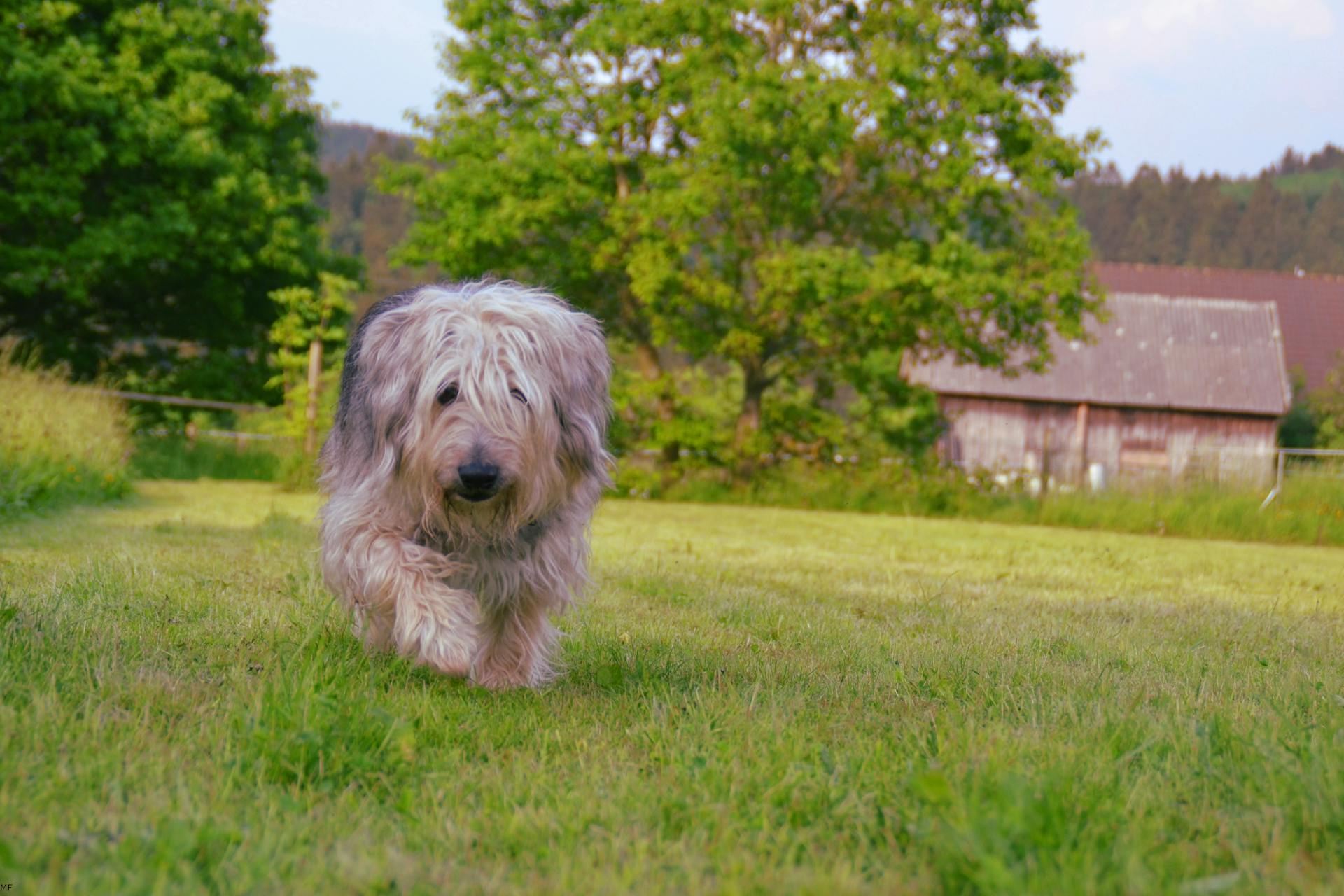
Dog chiropractors, also known as veterinary chiropractors, use spinal manipulation and other techniques to help improve a dog's range of motion, reduce pain, and enhance overall health.
Some dog owners have reported significant improvements in their pets' mobility and comfort after receiving chiropractic care.
Chiropractic adjustments can help alleviate pressure on a dog's joints and muscles, which can be especially beneficial for older dogs or those with mobility issues.
Research has shown that chiropractic care can be an effective treatment for dogs with musculoskeletal problems, such as hip dysplasia and arthritis.
What to Expect
You can expect your dog to be generally cooperative during a dog chiropractic adjustment, with the vast majority of animals doing well.
Some dogs may feel a little sore for the next day or so after the adjustment.
The dog's personality and pain level at the time of the visit can affect how they react.
Your pup may want to spend the remainder of the day resting after the adjustment.
Related reading: Work like a Dog Day
Benefits and Safety
Dog chiropractors can offer a wide range of benefits for dogs of all ages and breeds. Some of the most common benefits include pain relief, improved mobility, and better performance.
Chiropractic adjustments can help relieve pain and discomfort caused by musculoskeletal issues, such as joint stiffness, muscle soreness, and spinal misalignments. This can be especially beneficial for dogs with arthritis or age-related stiffness.
Improved mobility is another key benefit of dog chiropractic care. By restructuring the spine and joints, chiropractic treatments can increase a dog's range of motion and make it easier for them to move around.
Chiropractic care can also help promote faster healing by improving blood flow to affected areas and reducing inflammation. This can be especially helpful for dogs who have recently been injured.
Dog chiropractic is generally considered safe when performed by a trained and certified practitioner. However, it's essential to choose a qualified and experienced animal chiropractor who has undergone proper training and certification.
Here are some key things to look for in a qualified animal chiropractor:
It's also crucial to consult with your veterinarian before seeking chiropractic care for your dog, especially if your dog has certain conditions such as fractures, tumors, or severe arthritis.
Preparation and Consultation
Before seeking chiropractic care for your dog, it's essential to prepare them and yourself for the consultation. Gather relevant medical records, including imaging tests and pertinent medical data, to help the chiropractor understand your dog's medical history.
Inform the chiropractor of any concerns you have about your dog's health or behavior to ensure a safe and effective treatment. This will also help the chiropractor tailor the treatment to your dog's individual needs.
Taking your dog for a walk before the scheduled session can help them feel more comfortable and relaxed during the chiropractic treatment.
Take a look at this: Dog Chiropractor Cost
Before Seeking Care
Before seeking care, it's essential to consult with a veterinarian to rule out underlying medical conditions. This ensures that chiropractic care is appropriate for your dog's specific needs.
You'll also want to choose a certified animal chiropractor who has received specialized training in veterinary chiropractic techniques. Verify their credentials and ensure they have experience working with dogs.
Consider your dog's individual needs and health concerns. If you have any concerns, inform the chiropractor before the appointment. This will help them tailor the treatment to your dog's unique requirements.
A thorough medical history and any symptoms should be discussed with the chiropractor to develop an individualized treatment plan. Each dog is unique, and chiropractic treatment should address their specific musculoskeletal issues and health concerns.
Before the appointment, gather relevant medical records, including imaging tests or pertinent medical data. This will make it easier for the chiropractor to comprehend your dog's medical history and formulate a suitable treatment.
A brief walk before the scheduled session can help your dog feel more comfortable during the chiropractic treatment.
Consider Your
When preparing your dog for chiropractic care, consider their comfort level. Avoid collars or harnesses that impose strain on the neck or back, as these can interfere with treatment.
To ensure your dog's comfort, choose attire that doesn't restrict movement. This will make it easier for the chiropractor to perform adjustments and help your dog feel more relaxed during the session.
Some examples of comfortable attire for your dog include a well-fitting vest or a harness that distributes the weight evenly. Avoid anything that puts pressure on the neck or back, as this can cause discomfort and affect the treatment.
Here are some tips for choosing the right attire for your dog:
- Opt for a vest or harness that allows for easy movement.
- Choose a well-fitting garment that doesn't put pressure on the neck or back.
- Avoid collars or harnesses that impose strain on the neck or back.
By dressing your dog in comfortable attire, you can help them feel more relaxed and at ease during the chiropractic session. This will make the treatment more effective and ensure a positive experience for both you and your dog.
How It Works and What It Can Help
Dog chiropractors work by focusing on the musculoskeletal system, which includes the bones, joints, muscles, and soft tissues of the body. They help to realign the spine and joints with manual adjustments, which can decrease inflammation, improve mobility, and alleviate pain and suffering.
A canine chiropractor will carefully examine your dog's muscles and joints to locate areas of subluxation or restriction. These areas will be adjusted using hands-on techniques, which may involve applying light pressure or thrusts to specific body spots.
The goal of dog chiropractic care is to improve mobility and reduce pain, especially for conditions like IVDD, hip dysplasia, and arthritis. Chiropractors can also help with repetitive-use injuries and injured cranial cruciate ligaments.
Here are some common conditions that dog chiropractors can help alleviate:
- Intervertebral disc disease (IVDD)
- Hip dysplasia
- Luxating patellas
- Arthritis
- Repetitive-use injuries
- Injured cranial cruciate ligaments (CCL)
A canine chiropractor will typically perform a thorough exam and assessment, looking at how your dog moves and stands, as well as its anatomy. They may also take X-rays if necessary. The chiropractor will then perform an adjustment, either with an activator or their hands, and create a treatment plan going forward.
Potential Risks and Complications
Dogs may feel some discomfort or soreness after a chiropractic adjustment, which is usually mild and short-lived, but can be managed with rest and pain medications as needed.
It's essential to work with a qualified and experienced dog chiropractor who has the necessary training and expertise to perform adjustments safely, as serious nerve damage is rare but possible.
Chiropractic adjustments can put pressure on nerves and other sensitive structures, which is why a thorough physical exam and review of any relevant medical records or imaging studies are crucial before performing any adjustments.
While some side effects are normal, such as feeling soreness for more than two days, and expressing some vocal reaction, more severe side effects can occur if chiropractic care is performed prematurely and by those without the proper credentials.
Here are some potential complications to be aware of:
- Discomfort or soreness after a chiropractic adjustment
- Aggravation of pre-existing conditions, such as spinal fractures or herniated discs
- Nerve damage, although rare
Some Complications Include:
Discomfort is a normal side effect of dog chiropractic care, and it's usually mild and short-lived. It can be managed with rest and pain medications as needed.
Aggravation of pre-existing conditions is a rare but possible complication. This is why it's essential to work with a qualified and experienced dog chiropractor who has the necessary training and expertise.

Chiropractic adjustments can put pressure on nerves and other sensitive structures, which can lead to nerve damage. However, serious nerve damage is rare.
A dog may experience soreness after a chiropractic visit, but it's usually not for more than two days. Then they're back to normal.
If chiropractic care is performed prematurely or by someone without the proper credentials, you might see more severe side effects, such as worsening a pre-existing condition like a fracture or diabetes.
Here are some potential complications to be aware of:
- Discomfort or soreness after a chiropractic adjustment
- Aggravation of pre-existing conditions like spinal fractures or herniated discs
- Nerve damage, although rare
Doubts About Chiropractors
If you're skeptical about chiropractors, you're not alone. Many people have doubts about their effectiveness, especially when it comes to animal chiropractic care.
Harper, a doctor of chiropractic and certified animal chiropractor, has a message for skeptics: she's undergone four years of medical school and a 250-hour course on animal chiropractic care.
Some research suggests that animal chiropractic care may have a positive effect, but it's still a relatively unexplored field.
Veterinary Practice reports that animal chiropractic research is limited, but the available studies indicate a positive outcome.
Frequently Asked Questions
Is animal chiropractic legit?
Animal chiropractic is a controversial alternative therapy with limited scientific evidence, sparking debate among veterinarians and pet owners. While some swear by its benefits, its legitimacy remains a topic of discussion.
How often should a dog get a chiropractic adjustment?
For optimal health and happiness, dogs typically require 1-2 chiropractic adjustments per month, with some owners opting for quarterly maintenance treatments. Regular adjustments can help prevent future injuries and keep your dog feeling their best.
What to expect after a chiropractic adjustment for a dog?
After a chiropractic adjustment, your dog may feel relaxed and sleepy, or experience a temporary energy boost. Some dogs may feel sore for a day or two, especially after their first adjustment
Sources
- https://www.petmd.com/dog/when-see-dog-chiropractor-and-what-they-can-do
- https://palosanimalhospital.net/dog-chiropractic/
- https://www.dailypaws.com/living-with-pets/caregivers-services/dog-chiropractors
- https://melmagazine.com/en-us/story/does-dog-chiropractic-work
- https://www.reviveinjury.com/does-my-dog-need-a-chiropractor/
Featured Images: pexels.com


